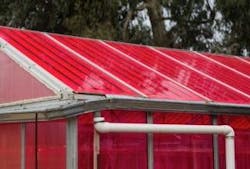Adding luminescent solar concentrators atop greenhouses doesn't hurt plant growth (and sometimes helps)
| Plants grown in this luminescent-concentrator-equipped greenhouse fared as well or better than plants grown in conventional greenhouses. (Photo by Nick Gonzales) |
Research greenhouses at the University of California, Santa Cruz equipped with electricity-producing luminescent solar concentrators are, for the first time, bearing fruit (vegetables, actually).1 The first crops of tomatoes and cucumbers grown in the greenhouses were as healthy as those raised in conventional greenhouses.
Usually shaped like a pane of glass, a luminescent solar concentrator is mostly transparent, but contains luminescent dye that absorbs light within a certain spectral range, then re-emits light at a different wavelength. This light is totally internally reflected within the plate, traveling laterally until it is absorbed and turned into electricity by narrow strips of photovoltaic cells either periodically embedded in the plate or placed at the plate's ends. These luminescent panels can concentrate sunlight even on perfectly cloudy days, a feat impossible for ordinary concentrating optics.
The luminescent solar concentrators on the UC Santa Cruz greenhouses have a magenta appearance, and they pass the red and a bit of the green and blue spectral regions while converting the rest of the blue and green light to electricity. Red and blue light are especially important for plant growth (for example, LED-equipped greenhouses often use red and blue LEDs), as shown by the fact that the vegetables grown in the UC Santa Cruz greenhouses were very healthy.
"We have demonstrated that 'smart greenhouses' can capture solar energy for electricity without reducing plant growth, which is pretty exciting," says Michael Loik, professor of environmental studies at UC Santa Cruz and one of the researchers.
Loik's team monitored photosynthesis and fruit production across 20 varieties of tomatoes, cucumbers, lemons, limes, peppers, strawberries, and basil grown in magenta glasshouses at two locations on campus and one in Watsonville, California.
"Eighty percent of the plants weren't affected, while 20% actually grew better under the magenta windows," says Loik. Tomatoes and cucumbers are among the top greenhouse-produced crops worldwide, he adds.
(Video: UC Santa Cruz)
In additional experiments, small water savings were associated with tomato photosynthesis inside the magenta greenhouses. "Plants required 5% less water to grow the same amount as in more conventional glasshouses," he says.
The so-called wavelength-selective photovoltaic systems (WSPV) technology was developed by Sue Carter and Glenn Alers, both professors of physics at UC Santa Cruz, who founded a company called Soliculture in 2012 to bring the technology to market. It should be noted that luminescent solar concentrators in general (in other words, not spectrally tailored for use in greenhouses) have been a focus of research by many scientists elsewhere (some of these concentrators are even colorless).
Cost per panel of WSPV technology is 65 cents per watt, about 40% less than the per-watt cost of traditional silicon-based photovoltaic cells.
Source: https://news.ucsc.edu/2017/11/loik-greenhouse.html
REFERENCE:
1. Michael E. Loik et al., Earth's Future (2017); doi: 10.1002/2016EF000531
